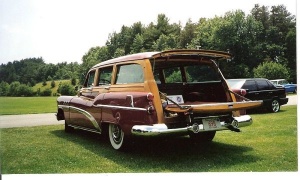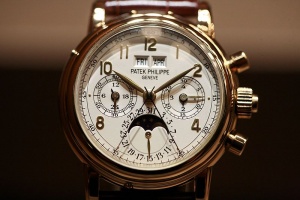Difference between revisions of "Chapter 19"
Redbarnlane (Talk | contribs) (Timeline) |
(→Page 343) |
||
| (10 intermediate revisions by 6 users not shown) | |||
| Line 1: | Line 1: | ||
{{Inherent Vice PbP Text}} | {{Inherent Vice PbP Text}} | ||
| − | + | ||
| − | + | ||
| − | + | ||
| − | + | ||
| − | + | ||
==Page 343== | ==Page 343== | ||
'''a mural depicting the arrival of the Portola expedition in 1769 at a bend of the river near what became downtown L.A.'''<br /> | '''a mural depicting the arrival of the Portola expedition in 1769 at a bend of the river near what became downtown L.A.'''<br /> | ||
| − | A real or imagined mural? | + | A real or imagined mural? Could Pynchon's description be somewhat inspired by the [http://www.ci.laguna-hills.ca.us/depts/admin/civic_center_public_art/online_exhibits/council_chamber_murals.asp mural] of Gaspar de Porlolá's expedition that is in the City of Laguna Hills Council Chamber meeting room? Mural by Robert Evans. |
'''The pictorial style reminded Doc of labels on fruit and vegetable crates'''<br /> | '''The pictorial style reminded Doc of labels on fruit and vegetable crates'''<br /> | ||
| Line 14: | Line 10: | ||
==Page 344== | ==Page 344== | ||
'''St. John's Episcopal Church'''<br> | '''St. John's Episcopal Church'''<br> | ||
| − | + | The reference may seem odd, as the church is now - and was in 1970 - a very liberal one. Of course, Crocker Fenway would have been married there in the 1940s, before its transformation from "an upper-level parish church controlled by businessmen" had occurred. Since 2008 referred to as [http://en.wikipedia.org/wiki/St._John's_Cathedral,_Los_Angeles St. John's Cathedral]. | |
| + | |||
| + | ==Page 347== | ||
| + | '''and its withdrawal into seemingly unbounded shadow'''<br> | ||
| + | Apparently another interior space which is larger than it would seem from outside, as on [http://inherent-vice.pynchonwiki.com/wiki/index.php?title=Chapter_2#Page_21 page 21]. | ||
| + | |||
| + | '''water rights ... all of that's ours, it's always been ours'''<br> | ||
| + | Perhaps a reference to the massive real estate fraud in the 1920's in which the ranchers and farmers of the Owens Valley were scammed out of their water rights by LA's rich and powerful elite, led by the Chandler family. This was the subject of the 1974 neo-noir film <i>Chinatown</i>. | ||
| + | |||
| + | '''We will never run out of you people. The supply is inexhaustible'''<br> | ||
| + | An echo of this, from page 192: "as long as American life was something to be escaped from, the cartel could always be sure of a bottomless pool of new customers." | ||
==Page 348== | ==Page 348== | ||
| Line 20: | Line 26: | ||
'''Patek Philippe moonphase'''<br> | '''Patek Philippe moonphase'''<br> | ||
An expensive watch, obviously: characteristics include a high value and a very complex and precise mechanism. Crocker Fenway's watch would, today, fetch a significant price: a 1968 watch (with some unusual characteristics) went for over $183,000 at a Christie's auction in November 2008. Older, and particularly rare, models have sold for over a million dollars. | An expensive watch, obviously: characteristics include a high value and a very complex and precise mechanism. Crocker Fenway's watch would, today, fetch a significant price: a 1968 watch (with some unusual characteristics) went for over $183,000 at a Christie's auction in November 2008. Older, and particularly rare, models have sold for over a million dollars. | ||
| − | + | ||
'''Parking lot at the May Company shopping mall...tomorrow evening.'''<br> | '''Parking lot at the May Company shopping mall...tomorrow evening.'''<br> | ||
| − | This conversation happens the evening of Wednesday May 6, 1970. | + | This conversation happens the evening of Wednesday May 6, 1970. |
| + | |||
'''Doc brought Denis along'''<br> | '''Doc brought Denis along'''<br> | ||
| − | Evening, Thursday May 7, 1970. | + | Evening, Thursday May 7, 1970. May 7 is the Feast of the Ascension in 1970. Jesus Christ, having been resurrected, returns bodily to heaven on this day. |
==Page 349== | ==Page 349== | ||
| − | '''1953 Buick Estate Wagon''' | + | '''1953 Buick Estate Wagon'''<BR> |
| − | [[File:1953BuickEstateWagon.jpg|thumb|left|Photo from [http://en.wikipedia.org/wiki/Buick_Estate Wikipedia]]]<br | + | [[File:1953BuickEstateWagon.jpg|thumb|left|Photo from [http://en.wikipedia.org/wiki/Buick_Estate Wikipedia]]] |
| + | |||
| + | ==Page 350== | ||
| + | '''a beat-up El Camino which could only be Bigfoot's'''<br> | ||
| + | This shows, it seems (though it is not explicitly stated), that Doc's paranoia about the LAPD searching for him in order to recover the heroin (helicopters and so forth) was unnecessary. Bigfoot didn't want to pop Doc for the smack; he wanted to see where the smack would end up, and follow that trail himself. | ||
{{Inherent Vice PbP}} | {{Inherent Vice PbP}} | ||
Latest revision as of 19:51, 20 April 2015
- Please keep these annotations SPOILER-FREE by not revealing information from later pages in the novel.
Page numbers refer to editions with 369 pages, where the story begins on page 1. Not sure if there are other editions with variant pagination. Please let us know otherwise.
Page 343
a mural depicting the arrival of the Portola expedition in 1769 at a bend of the river near what became downtown L.A.
A real or imagined mural? Could Pynchon's description be somewhat inspired by the mural of Gaspar de Porlolá's expedition that is in the City of Laguna Hills Council Chamber meeting room? Mural by Robert Evans.
The pictorial style reminded Doc of labels on fruit and vegetable crates
Southern California used to be full of fruit/vegetable orchards. And local farms would develop their own crate labels. Here are some examples.
Page 344
St. John's Episcopal Church
The reference may seem odd, as the church is now - and was in 1970 - a very liberal one. Of course, Crocker Fenway would have been married there in the 1940s, before its transformation from "an upper-level parish church controlled by businessmen" had occurred. Since 2008 referred to as St. John's Cathedral.
Page 347
and its withdrawal into seemingly unbounded shadow
Apparently another interior space which is larger than it would seem from outside, as on page 21.
water rights ... all of that's ours, it's always been ours
Perhaps a reference to the massive real estate fraud in the 1920's in which the ranchers and farmers of the Owens Valley were scammed out of their water rights by LA's rich and powerful elite, led by the Chandler family. This was the subject of the 1974 neo-noir film Chinatown.
We will never run out of you people. The supply is inexhaustible
An echo of this, from page 192: "as long as American life was something to be escaped from, the cartel could always be sure of a bottomless pool of new customers."
Page 348
Patek Philippe moonphase
An expensive watch, obviously: characteristics include a high value and a very complex and precise mechanism. Crocker Fenway's watch would, today, fetch a significant price: a 1968 watch (with some unusual characteristics) went for over $183,000 at a Christie's auction in November 2008. Older, and particularly rare, models have sold for over a million dollars.
Parking lot at the May Company shopping mall...tomorrow evening.
This conversation happens the evening of Wednesday May 6, 1970.
Doc brought Denis along
Evening, Thursday May 7, 1970. May 7 is the Feast of the Ascension in 1970. Jesus Christ, having been resurrected, returns bodily to heaven on this day.
Page 349
1953 Buick Estate Wagon

Page 350
a beat-up El Camino which could only be Bigfoot's
This shows, it seems (though it is not explicitly stated), that Doc's paranoia about the LAPD searching for him in order to recover the heroin (helicopters and so forth) was unnecessary. Bigfoot didn't want to pop Doc for the smack; he wanted to see where the smack would end up, and follow that trail himself.
| Chapter 1 pp. 1-18 |
Chapter 2 pp. 19-45 |
Chapter 3 pp. 46-49 |
Chapter 4 pp. 50-54 |
Chapter 5 pp. 55-67 |
| Chapter 6 pp. 68-88 |
Chapter 7 pp. 89-110 |
Chapter 8 pp. 111-123 |
Chapter 9 pp. 124-153 |
Chapter 10 pp. 154-162 |
| Chapter 11 pp. 163-185 |
Chapter 12 pp. 186-206 |
Chapter 13 pp. 207-234 |
Chapter 14 pp. 235-255 |
Chapter 15 pp. 256-274 |
| Chapter 16 pp. 275-295 |
Chapter 17 pp. 296-314 |
Chapter 18 pp. 315-342 |
Chapter 19 pp. 343-350 |
Chapter 20 pp. 351-363 |
| Chapter 21 pp. 364-369 |
